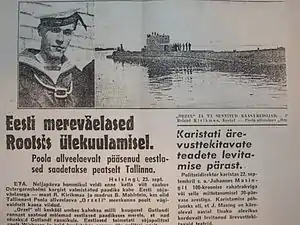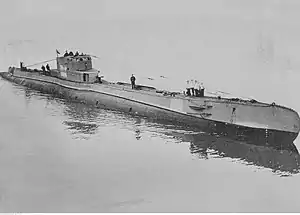Orzeł incident
The Orzeł incident[1] occurred at the beginning of World War II. The Polish submarine ORP Orzeł escaped from Tallinn in then-neutral Estonia to the United Kingdom. The Soviet Union used the incident as a pretext to justify the eventual occupation of Estonia.
 The Orzeł incident covered in the Estonian newspaper "Uus Eesti" (New Estonia). | |
| Date | 18 September 1939 |
|---|---|
| Location | Tallinn, Estonia |
| Cause | Polish submarine interned by neutral Estonia |
| Outcome | Polish submarine escapes |
| Casualties | |
| 2 Estonian guards captured[Note 1] | |
| Submarine Orzeł damaged | |
Background
Orzeł was docked at Oksywie when Nazi Germany attacked Poland, setting off World War II. The submarine initially participated in Operation Worek, but withdrew from the Polish coast on 4 September as the situation evolved. Damaged by German minesweepers and leaking oil, the decision was made to head for Tallinn, which was reached on 14 September 1939 at about 01:30.[2] Lieutenant-Commander Henryk Kłoczkowski, the commanding officer, was taken to a hospital the next day for treatment of the unidentified illness he had been suffering from since 8 September.
The Hague Convention of 1907 enjoined signatories, including Germany, from interfering with the right of enemy warships to use neutral ports, within certain limits. Initially, the Estonians were quite accommodating of Orzeł, assisting with the repair of a damaged compressor.[2] However, probably because of German pressure, Estonian military authorities soon boarded the ship, declared the crew interned, confiscated all the navigation aids and maps, and commenced dismantling all the armaments. An Estonian officer removed the naval ensign at the submarine's stern.[3]
The incident
Escape

The crew of ORP Orzeł conspired to escape under the new command of its chief officer, Lt. Jan Grudziński, and its new first officer, Lieutenant Andzej Piasecki.[4] This started with Grudziński's sabotage of the torpedo hoist on 16 September, preventing the Estonians from removing the six aft torpedoes. Since it was a Sunday, another one couldn't be immediately acquired. Meanwhile, Boatswain Wladyslaw Narkiewicz took a small boat around the harbour. Under the guise of fishing, he covertly measured the depth of the planned escape route.[3] Another sailor sabotaged the submarine's mooring lines.[5]
At around 00:00 on 18 September, the port lights suffered an unexplained malfunction. Seizing the opportunity, Lieutenant Grudziński prepared the submarine for departure. The crew was forced to delay by the arrival of an Estonian officer. After a 30-minute inspection, he deemed nothing to be out of the ordinary and bid the Poles goodnight. The crew resumed with their plans. Two Estonian guards at the dock were lured aboard and nonviolently taken prisoner, the lighting in the port was intentionally sabotaged, and the mooring lines were cut with an axe. Both engines were started, and the submarine made her escape in the darkness.[3]
Estonian spotlights began sweeping the harbour, from the buildings to the quay, before finally locking onto Orzeł. The Estonians opened up with machine guns and light artillery, damaging the conning tower. Heavier guns supposedly didn't open fire for fear of damaging other ships. At the mouth of the harbor the submarine briefly ran aground on a sandbar, but quickly managed to get free and escape into the Baltic.[4]
At sea
Lieutenant Grudziński intended to seize the maps of a German vessel, as all of Orzeł's navigational aids, with the exception of a guide of Swedish lighthouses, had been confiscated. No German merchantmen were ever spotted, though. After three weeks of searching, it was decided to leave the Baltic and head for Britain. It took two days to pass through the heavily guarded entrance. The only references the Poles had were the lighthouse guide and a rudimentary map drawn by the navigation officer.[4]
The Estonian and German press covering the incident claimed that the two captured guards had been murdered by the Polish sailors. In reality they were deposited off of the Swedish coast in a rubber dingy provided with clothing and food for their safe return home. The two guards were also provided with 50 US dollars each, as the Polish crew believed that those returning from the underworld "deserve to travel first class only."[6]
Orzeł made landfall off of Scotland on 14 October. The crew sent out a signal in broken English, and a British destroyer came out and escorted them into port. Orzeł's arrival came a surprise to the Admiralty, which had long presumed the submarine lost.[4]
Aftermath
ORP Orzeł was subject to a refit and subsequently brought into service alongside the Royal Navy in the 2nd Submarine Flotilla in mid-January 1940 to patrol the North Sea.[4][7]
Ramifications
Following the event, the Telegraph Agency of the Soviet Union reported that the Estonian government had deliberately allowed Orzeł to escape and that other Polish submarines were hiding in ports throughout the Baltic states.[8]
The Soviet Union, which invaded Poland on 17 September 1939, accused Estonia of conspiring with the Polish seamen and "aiding them to escape", challenging the neutrality of Estonia. The Soviets demanded to be allowed to establish military bases on Estonian soil, threatening war if Estonia did not comply. This served as a political cover for their actions, as the Molotov-Ribbentrop Pact had already given German approval to the Soviet Union taking over the Baltic countries. The Orzeł incident was used to force a "pact of defence and mutual assistance" on Estonia, which was signed on 28 September 1939, and allowed for the occupation and annexation of Estonia by the Soviet Union in 1940.
Orzeł sank no enemy vessels during her journey from Estonia to Britain, although Soviet authorities blamed her for the loss of the Soviet tanker Metallist in Narva Bay on 26 September, the incident being used as a pretext for the Soviet occupation of the Baltic states (1940).
Notes
- The captured Estonian guards were later set free in Sweden.
References
- His Majesty's Submarines; p 19; ISBN 1-57638-021-1
- Kuzak, Rafal (31 October 2013). "Największy zdrajca z kampanii wrześniowej? Haniebna dezercja dowódcy ORP Orzeł". ciekawostki historyczne (in Polish). Retrieved 20 February 2016.
- Kuzak, Rafal (23 November 2013). "Orzeł wyzwolony. Brawurowa ucieczka z Tallina". ciekawostki historyczne (in Polish). Retrieved 20 February 2016.
- Haar, Geirr H. The Gathering Storm p. 53
- Kelly, C. Brian (1 November 2010). Best Little Stories from World War II: More Than 100 True Stories. Sourcebooks, Inc. pp. 21–24. ISBN 9781402243585.
- Pertek, Jerzy (1987). Wielkie dni małej floty (10th ed.). Poznań: Wydawnictwo Poznańskie. p. 134. ISBN 832100542X.
- Haar, Geirr H (2015). No Room for Mistakes: British and Allied Submarine Warfare 1939–1940. Casemate Publishers. p. 302. ISBN 9781473875319.
- Crowe, David (19 January 1993). The Baltic states and the great powers: foreign relations, 1938–1940 (illustrated ed.). Westview Press. p. 88. ISBN 9780813304816.
